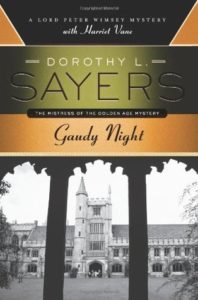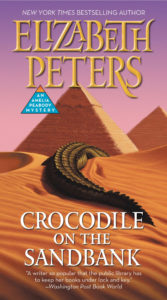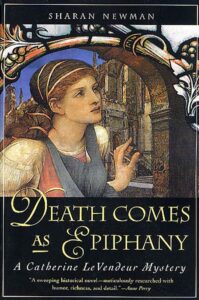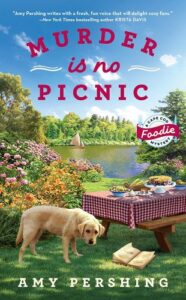Honestly, if you are reading this essay, I probably already know one thing about you: You devoured the Nancy Drew mysteries as a child. And from that moment on, you were hooked on the female amateur sleuth (aka, the FAS). What drew you to her? Why did you progress at speed from the gateway drug of Nancy to Miss Jane Marple, to Amelia Peabody, to Blanche White, to… the list goes on and on. I would argue that it is because there is something about the female amateur sleuth that is, at heart, radical. Radical as in, to quote Merriam-Webster, “very different from the usual or traditional.”
First of all, she consistently upends society’s traditional view of women and girls as essentially harmless, biddable creatures. Even when the FAS appears to be conventional, like Agatha Christie’s Miss Jane Marple, that appearance is almost always deceptive. As a character in The Murder at the Vicarage points out: “Miss Marple is a white-haired old lady with a gentle appealing manner—Miss Wetherby is a mixture of vinegar and gush. Of the two, Miss Marple is the more dangerous.” Hah. Do not EVER underestimate the female amateur sleuth.
She is also unapologetically smart and will not be condescended to. Just listen to Elizabeth Peters’ archaeologist Amelia Peabody, who says bluntly, “I have been accused of being somewhat abrupt in my actions and decisions, but I never act without thought; it is simply that I think more quickly and more intelligently than most people.” Or Alan Brady’s eleven-year-old chemistry prodigy Flavia de Luce, muttering between clenched teeth, “If there is a thing I truly despise, it is being addressed as “dearie.”
Which is not to say that the female amateur sleuth doesn’t also suffer pangs of the heart and/or have a good hearty sex drive. Who doesn’t feel for Dorothy Sayers’ scholarly Harriet Vane when she cries out in Gaudy Night, “What are you to do with the people who are cursed with both hearts and brains?” Or how about this exchange between Sharan Newman’s 12th century novitiate Catherine LeVendeu and her interlocutor: “Catherine Le Vendeur,” he asked sententiously, “have you known this man carnally?” “No father,” Catherine answered. “But, with your kind permission, I would very much like to.”
Third, and perhaps most compelling, the FAS comes in fascinating variety. To read mysteries with female amateur sleuths is to open windows to other cultures (and cuisines!), other times in history, other stages of life, other lived experiences. It is to open your mind to new ideas. As Olivia Yu’s Singaporan Aunty Lee suggests: “People ought to go through the ideas they carried around in their heads as regularly as they turned out their store cupboards. No matter how wisely you shopped, there would be things in the depths that were past their expiration dates or gone damp and moldy.”
And perhaps most radically, even when her circumstances would seem to argue the opposite, the female amateur sleuth has agency. Here’s Barbara Neely’s Blanche White, a Black cook and housekeeper to wealthy white families in the American South: “For all the chatelaine fantasies of some of the women for whom she worked, she really was her own boss, and her clients knew it. She ordered her employers’ lives, not the other way around.”
But perhaps the most singular characteristic that female amateur sleuths share is sheer persistence. They simply will not stop sleuthing, no matter who or what stands in their way. Because, as my own female amateur sleuth, the disgraced ex-chef and world’s most reluctant YouTube star Sam Barnes (aka the Cape Cod Foodie) puts it, “Here’s the thing. As a general rule I don’t think people should get away with killing other people.”
Below in chronological order based on the first book in their series are seven of my favorite female amateur sleuths. I commend them all to you.

Agatha Christie’s Jane Marple
The Murder at the Vicarage (1930)
“I always find it prudent to suspect everybody just a little. What I say is, you really never know, do you?”
In Agatha Christie’s The Murder at the Vicarage we are introduced to Miss Jane Marple of the quaint English village of St. Mary Mead, which, as one reviewer pointed out, is in fact “a hotbed of burglary, impersonation, adultery and ultimately murder.” Nor is Miss Marple exactly what she appears to be. As Sergeant Cornish so accurately points out in The 4:50 from Paddington, “Everybody in St Mary Mead knew Miss Marple; fluffy and dithery in appearance, but inwardly as sharp and as shrewd as they make them.” And we love her for it.

Dorothy Sayers’ Harriet Vane
Gaudy Night (1935)
“A marriage of two independent and equally irritable intelligences seems to me reckless to the point of insanity.”
Okay, this one is a bit of a cheat. Harriet Vane actually first appears in Dorothy Sayers’ Strong Poison, but it is in Gaudy Night, when the dons of Harriet’s alma mater, the all-female Shrewsbury College, Oxford, invite her back to investigate a series of poison pen letters and acts of vandalism that Harriet really comes into her own as a sleuth. By the end of the book Harriet (okay, with the besotted Lord Peter Wimsey’s help) has unmasked the villain and (joy!) finally accepted Wimsey’s proposal.

Elizabeth Peters’ Amelia Peabody
Crocodile on the Sandbank (1975)
“Men are frail creatures, of course; one does not expect them to exhibit the steadfastness of women.”
I can still remember my delight when, as an archaeology student myself, the wonderful Victorian-era Egyptologist, Amelia Peabody, made her debut in Crocodile on the Sandbank in 1975. That delight continued for some twenty novels in this witty, wry series written (sometimes, I am convinced, with tongue firmly in cheek) by Egyptologist Barbara Mertz under the pen name Elizabeth Peters.

Sharan Newman’s Catherine LeVendeur
Death Comes as Epiphany (1993)
“Before all these people, her father had praised her. Not for docility or embroidery or music, but for the one quality she had thought he despised, her clarity of thought.”
What do you do when a medieval scholar Sharan Newman writes a mystery entitled Death Comes as Epiphany set in twelfth-century France and featuring a young scholar who has come to conquer her sin of pride at the Convent of the Paraclete, famous for learning, prayer, and its abbess, the fabled Heloise? Why, you give that novel both the Agatha Award and the Macavity Award for “Best First Novel,” of course. And then you sit back and enjoy the next ten novels in this remarkable, beautifully written series.

Alan Bradley’s Flavia de Luce
The Sweetness at the Bottom of the Pie (2009)
“When I write my magnum opus, A Treatise Upon All Poisons, and come to ‘Cyanide,’ I am going to put under ‘Uses’ the phrase ‘Particularly efficacious in the cure of those who call one ‘Dearie.’ “
I confess, I have a special place in my heart for Flavia de Luce, Alan Bradley’s precocious eleven-year-old amateur detective and aspiring chemist with a passion for poison. There’s something almost heartbreaking about this fierce, funny, lonely little girl (“I was me. And I loved myself, even if no one else did.”). Plus, how can you laugh not out loud at a bit like this one:
“I found a dead body in the cucumber patch,’ I told them.
“How very like you,” Ophelia said, and went on preening her eyebrows.

Barbara Neely’s Blanche White
Blanche on the Lam (1992)
“He gave Blanche the cheeky “Hey, girl” greeting that teenage white boys working up to being full-fledged rednecks give grown black women in the South.”
If you haven’t yet met Blanche White, who, when Blanche on the Lam was published became the first Black female series sleuth in mainstream American publishing, you owe it to yourself to get your hands on a copy of this book immediately. The four book series—often described as what Toni Morrison would write if Toni Morrison wrote mysteries—features the indomitable Blanche, a Black domestic worker who uses the invisibility inherent in her job as an advantage in pursuit of the truth. After all, as Blanche well knows, “A family couldn’t have domestic help and secrets.”

Ovidia Yu’s Aunty Lee
Aunty Lee’s Delights (2013)
“Had it been an accident, suicide or – most exciting of all murder? Naturally, Aunty Lee was all in favor of suicide or murder. She did not find accidents very interesting.”
Okay, so I write culinary cozy mysteries. And my oldest has lived in Singapore for the past 12 years. But even with those biases, I would love Ovidia Yu’s Aunty Lee novels. Start with Aunty Lee’s Delights, a clever mystery that introduces the outspoken Rosie “Aunty” Lee, feisty widow, amateur sleuth and proprietor of the best-loved home cooking restaurant in Singapore, a city where money flows freely and people of many religions and ethnicities co-exist peacefully, but where tensions lurk just below the surface, sometimes with deadly results.
***


















